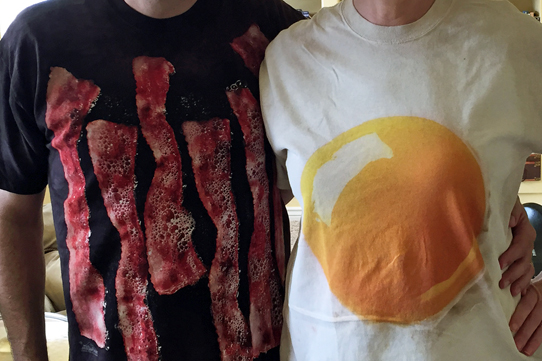

You.
How to make homemade bacon.
Anytime and all the time.
At home.
Huh? Because it’s bacon!
The basic description: 1. Get some pork belly. Some people call it “side pork.” Part of a pork belly, a few pounds, will do. The butcher at your local grocery store may have some in the back, and should cut it in two for you if you want less than a whole slab, or if you want to cure some now and keep some frozen for later. Otherwise, try specialty stores, perhaps ethnic specialty stores. Your butcher ought to give you a decent price on pork belly, so making homemade bacon should not be much more expensive than buying store bought bacon, but will be much tastier, and will probably even be safe to eat! 2. As soon as you get home, wash and dry the pork belly, and carefully and patiently with a sharp knife remove the rind (skin) if it’s still on; this task can be difficult. Then salt the pork belly with curing salt and whatever else you’re curing it with (see “Notes” below). Pat the cure all over the meat. 3. Put the pork belly in a large Ziplock bag, two gallon size or larger if necessary, and put it in the refrigerator. Make very sure that the refrigerator is at 36–40 degrees. Leave it in for one week. 4. While the pork belly is in the refrigerator, flip the bag over once a day. Make sure it doesn’t leak. 5. After a week, the pork belly should be much firmer. Give it more time if it’s still squishy. 6. Rinse the bacon very thoroughly, over several minutes, so the bacon isn’t too salty. Then pat it dry. Some people further dry it uncovered in the refrigerator for a day because they think it gives the meat a pellicle, a coating that helps with the smoking. 7. Smoke the pork belly until it reaches 150°–160°, using a smoker or a modified grill to do this low and slow with hardwood smoke, perhaps hickory or apple; it is possible to skip this step, but then your bacon will not be as good. After smoking, cut off the rind without cutting yourself if you didn’t remove it initially. 8. Use a sharp knife or a food slicer to slice the bacon. This will be much easier if the bacon is refrigerated awhile first to firm it up. Don’t cut your finger. If you do, your spouse will have to take you to the doctor, and that isn’t so fun.
Notes on making the cure: What follows are dry cures; you can look up wet cures elsewhere if you want to use a brine. It is possible to cure with only salt and sugar, but it takes a lot more of the cure, the bacon color won’t be as pink, and there will be increased risk of spoilage and possible botulism since there’s no sodium nitrite. People who prattle on about natural cures and the evil of nitrates apparently miss the fact that supposedly natural cures like celery salt are loaded with nitrates from the celery, but you don’t know the exact concentration. For curing salt, your grocery store probably has Morton Tender Quick, so it may be most convenient to obtain, although I prefer using pink curing salt (also called Insta Cure #1, or Prague powder #1), but it’s harder to find and usually has to be ordered online. Pink curing salt only has sodium nitrite, instead of sodium nitrite, sodium nitrate, and added salt and sugar, as has Tender Quick. Don’t let anyone mistakenly use any kind of curing salt as table salt (Instacure is pink in order to prevent that)! That would be unsafe! If you use Tender Quick, use one tablespoon of Tender Quick per pound of meat, along with a little less sugar than the amount of Tender Quick. If you use pink curing salt, use a fourth of a teaspoon of pink curing salt per pound of meat, and add sugar and regular salt. One recipe calls for using five times as much sugar as pink curing salt, and ten times as much regular salt as pink curing salt; just swirl it together in a bowl before applying it (describing it in ratios allows scaling to whatever amount of meat you’re curing). It is possible to include brown sugar, maple syrup, or savory spices in the curing process, to give the bacon some specific flavors, and brown sugar is a good idea. A good savory cure is for each part of pink curing salt, use 3 parts of thyme, 6 parts of crumbled sage, 6 parts of ground juniper berries, 6 parts of black pepper, 12 parts of brown sugar, and 24 parts of salt. You may have noticed that the simple pink curing salt recipe differs from the savory pink curing salt recipe in how much sugar and non-pink salt to use. From what I’ve seen on the oh-so-trusty Internet, there isn’t a precise science to this. Having said that, I subsequently noticed that not long ago Meathead put up some good bacon making information on his web site, at http://amazingribs.com/recipes/porknography/making_bacon_from_scratch.html; he seems to like a higher ratio of sugar to added salt.
Eating the bacon: Homemade bacon is fried normally, but keep an eye on it because it may cook a little differently due to moisture content and slice thickness differences. Baking bacon is also possible (put it on a rack on a pan in the oven and cook it at 400° until it’s done, perhaps 15–20 minutes). If you want lardons, you can cube up some of the bacon instead of slicing it. Although it is possible to survive for a few days without bacon, it is not recommended.